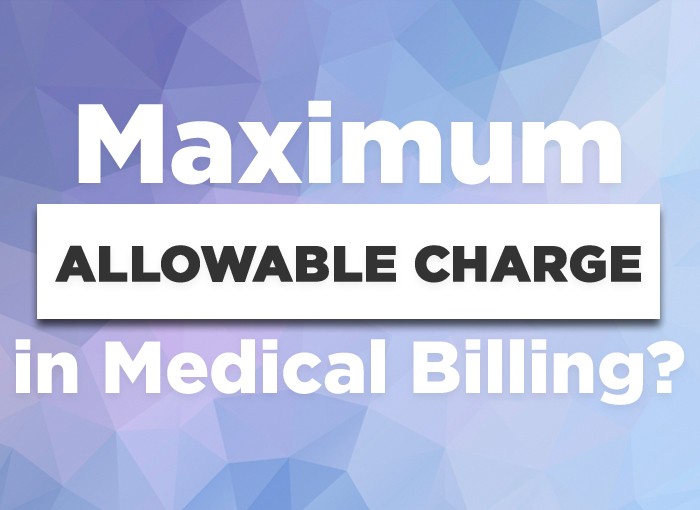What is the Maximum Allowable Charge in Medical Billing
The health sector operates based on payments received from patient services and insurance providers. Hospitals need successful revenue processing to purchase essential medical tools and maintain running diagnostic labs while supporting staff and patient care. Healthcare facilities work together with both government and private insurance organizations to maximize their insurance claim payments. However, every health insurance payer has a fixed allowable charge of reimbursement for various medical services. The health insurance payer will pay neither less nor more than the allowable charge. This is where the term maximum allowable charge in medical billing comes in.
Understanding Maximum Allowable Charge
In simple words, the maximum allowable charge shows how much health insurance pays for each medical procedure based on what the insurance company decides to cover. The insurance payer lets their patients receive a certain amount for medical procedures while they commit to pay that portion afterward. The patient becomes responsible for any unpaid portions after insurance has handled their share.
The amount of allowable charge may include:
- The amount negotiated with (participating) providers.
- The amount estimated by the law.
- The amount is fixed as per the Fee Schedule.
Healthcare providers typically charge more than insurance companies approved for services. The insurance payer must only pay the approved amount based on their fixed rate. When insurance coverage does not cover treatment costs healthcare providers should not bill patients for the remaining balance. The patient needs to pay the prescribed copay or coinsurance amount that shows on their insurance card. Medical service providers need to let go of all money that exceeds the established reimbursement limits.
However, if the patient does not have any health care insurance plan then he/she is required to the estimated amount as charged by the physician. A maximum allowable charge is only applicable to patients with the health care insurance plan.
Also, the patient should only visit the hospitals that have a partnership with the selected healthcare insurance network. For example, if you are a Medicare patient then you should only visit the hospitals where the Medicare plan is supported and followed.
Role of Maximum Allowable Charge in Medical Billing
Generating the superbill and filing the health care insurance claims tend to create a lot of confusion due to any discrepancy in the reimbursed payment. To avoid such confusion and eliminate discrepancies, both government and private healthcare insurance providers prefer to fix a particular amount for a particular medical procedure.
The patient, healthcare provider, and insurance provider need to set a consistent payment value. The health care provider accepts payment from the patient and insurance company who both participate in covering the total amount. The insurance plan’s maximum procedure fee approval ensures proper reimbursement of authorized services without fraud.
Factors Influencing Maximum Allowable Charges
The maximum allowable charge for medical procedures is determined by various factors that insurance payers consider when establishing reimbursement rates. These factors include:
- Geographic location and cost of living adjustments
- Complexity and duration of the medical procedure
- Provider specialty and expertise level
- Facility type (hospital, ambulatory surgical center, physician’s office)
- Market competition and regional healthcare costs
- Medicare guidelines and industry standards
Impact on Healthcare Providers
Healthcare providers must carefully consider MAC rates when participating in insurance networks, as these rates directly affect their revenue cycle and financial sustainability. Providers often:
- Analyze MAC rates across different insurance networks before signing contracts
- Calculate their cost-to-charge ratios to ensure financial viability
- Maintain detailed documentation to justify charges
- Invest in proper coding and billing staff training to maximize appropriate reimbursement
- Regular review and adjustment of their charge master to align with MAC rates
Different Types of Maximum Allowable Charges
Insurance payers may implement various types of MAC structures:
- Fixed Fee Schedule MAC
- Predetermined rates for specific procedures
- Usually based on CPT or HCPCS codes
- Updated annually or bi-annually
- Percentage-based MAC
- Calculated as a percentage of Medicare rates
- Common in commercial insurance contracts
- May vary by service type or specialty
- Dynamic MAC
- Adjusts based on market conditions
- Takes into account supply and demand
- May change quarterly or semi-annually
How Maximum Allowable Charge Works
- Rate Negotiation
- The insurance company negotiates rates with the providers of healthcare.
- These negotiated rates provide the basis for the MAC.
- Service Provision
- A patient gets treatment from a provider.
- The provider creates a claim stating the services and the amount charged.
- Claim Processing
- The insurance company verifies that the services are included under the patient’s policy.
- For each service, the MAC is applied to establish the reimbursement.
- Reimbursement and Patient Responsibility
- The insurance pays the provider for services provided with MAC.
- Costs not paid for, which could include costs to patients out of pocket, the provider collects.
Conclusion
This is the maximum allowable charge, which is the foundation of clinical billing, regulating how much the insurers pay the carriers and influencing what patients pay. In setting an upper limit to the amount paid in reimbursements, the MAC ensures value control and consistency within the industry. However, its complexities and versions can pose challenges for the sufferers, providers, and insurers.
Understanding the MAC, its calculation, and its implications can empower all stakeholders to navigate the clinical billing panorama extra efficaciously. Through clear verbal exchange, accurate billing practices, and proactive management, the challenges related to the MAC can be minimized, ensuring a smoother revel for everyone concerned.



